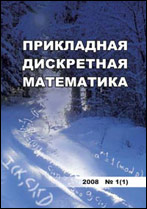|
This article is cited in 5 scientific papers (total in 5 papers)
Mathematical Methods of Cryptography
Cryptautomata with functional keys
G. P. Agibalov
National Research Tomsk State University, Tomsk, Russia
Abstract:
In this paper, we describe the cryptautomata and some cryptanalysis techniques for them. In cryptographic systems, the cryptautomata are widely used as its primitives including key-stream generators, s-boxes, cryptofilters, cryptocombiners, key hash functions as well as symmetric and public-key ciphers, digital signature schemes. Here, a cryptautomaton is defined as a class $C$ of automata networks of a fixed structure $N$ constructed by means of the series, parallel, and feedback connection operations over initial finite automata (finite state machines) with transition and output functions taken from some predetermined functional classes. A cryptautomaton key can include initial states, transition and output functions of some components in $N$. The choosing a certain key $k$ produces a certain network $N_k$ from $C$ to be a cryptographic algorithm. In case of invertibility of $N_k$, this algorithm can be used for encryption. The operation (functioning) of any network $N_k$ in the discrete time is described by the canonical system of equations of its automaton. The structure of $N_k$ is described by the union of canonical systems of equations of its components. The cryptanalysis problems for a cryptautomaton are considered as the problems of solving the operational or structural system of equations of $N_k$ with the corresponding unknowns that are key $k$ variables and (or) plaintexts (input sequences). For solving such a system $E$, the method DSS is used. It is the iteration of the following three actions: 1) $E$ is Divided into subsystems $E'$ and $E''$, where $E'$ is easy solvable; 2) $E'$ is Solved; 3) the solutions of $E'$ are Substituted into $E''$ by turns. The definition and cryptanalysis of a cryptautomaton are illustrated by giving the example of the autonomous cryptautomaton with the alternative control. It is a generalization of the LFSR-based cryptographic alternating step generator. We present a number of attacks on this cryptautomaton with the states or output functions of its components as a key.
Keywords:
finite automaton, automata network, cryptautomaton, cryptautomaton generator with alternative control, cryptanalysis, linearization attack, “devide-and-solve-and-substitute”, partially defined function completion.
Citation:
G. P. Agibalov, “Cryptautomata with functional keys”, Prikl. Diskr. Mat., 2017, no. 36, 59–72
Linking options:
https://www.mathnet.ru/eng/pdm578 https://www.mathnet.ru/eng/pdm/y2017/i2/p59
|

| Statistics & downloads: |
| Abstract page: | 283 | | Full-text PDF : | 125 | | References: | 36 |
|




 Contact us:
Contact us: Terms of Use
Terms of Use
 Registration to the website
Registration to the website Logotypes
Logotypes








 Citation in format
Citation in format 
